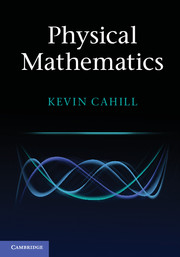Book contents
- Frontmatter
- Contents
- Preface
- 1 Linear algebra
- 2 Fourier series
- 3 Fourier and Laplace transforms
- 4 Infinite series
- 5 Complex-variable theory
- 6 Differential equations
- 7 Integral equations
- 8 Legendre functions
- 9 Bessel functions
- 10 Group theory
- 11 Tensors and local symmetries
- 12 Forms
- 13 Probability and statistics
- 14 Monte Carlo methods
- 15 Functional derivatives
- 16 Path integrals
- 17 The renormalization group
- 18 Chaos and fractals
- 19 Strings
- References
- Index
10 - Group theory
- Frontmatter
- Contents
- Preface
- 1 Linear algebra
- 2 Fourier series
- 3 Fourier and Laplace transforms
- 4 Infinite series
- 5 Complex-variable theory
- 6 Differential equations
- 7 Integral equations
- 8 Legendre functions
- 9 Bessel functions
- 10 Group theory
- 11 Tensors and local symmetries
- 12 Forms
- 13 Probability and statistics
- 14 Monte Carlo methods
- 15 Functional derivatives
- 16 Path integrals
- 17 The renormalization group
- 18 Chaos and fractals
- 19 Strings
- References
- Index
Summary
What is a group?
A group G is a set of objects f, g, h, … and an operation called multiplication such that:
if f ∈ G and g ∈ G, the product fg ∈ G (closure);
if f, g, and h are in G, then f(gh) = (fg)h (associativity);
there is an identity e ∈ G such that if g ∈ G, then ge = eg = g;
every g ∈ G has an inverse g −1 ∈ G such that gg −1 = g −1 g = e.
Physical transformations naturally form groups. The product T′ T represents the transformation T followed by the transformation T′. And both T″ (T′ T) and (T″ T′) T represent the transformation T followed by the transformation T′ and then by T″. So transformations are associative. The identity element e is the null transformation, the one that does nothing. The inverse T −1 is the transformation that reverses the effect of T. Such a set {T} of transformations will form a group if any two successive transformations is a transformation in the set (closure). Closure occurs naturally when the criterion for membership in the group is that a transformation not change something. For if both T and T′ leave that thing unchanged, then so will their product T′ T.
Example 10.1 (Groups of coordinate transfor mations) The set of all transformations that leave invariant the distance from the origin of every point in n-dimensional space is the group O(n) of rotations and reflections. The rotations in R n form the group SO(n).
- Type
- Chapter
- Information
- Physical Mathematics , pp. 348 - 399Publisher: Cambridge University PressPrint publication year: 2013



